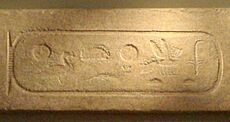Nomen (ancient Egypt) facts for kids
Quick facts for kids Nomen in hieroglyphs |
||||
|---|---|---|---|---|
sˁ-Rˁ Sa-Rê Son of Rê |
||||
| Cartouche name of king Khafra with the Niswt-Bity name and the Sa-Rê title inside | ||||
The nomen was a special name for ancient Egyptian pharaohs. It was one of their "five great names". King Djedefre from the 4th Dynasty first used it. He added it to the traditional nswt-bity name. Later, the nomen became its own important royal name.
Contents
What is the Pharaoh's Nomen?
The word nomen refers to a pharaoh's birth name. It was one of the five important names a pharaoh had. This name was often written inside a special oval shape called a cartouche. The cartouche showed that the name belonged to a king or queen.
The Meaning of Sa-Rê
The nomen was introduced with the title Sa-Rê. This means "Son of Ra". Ra was the powerful sun god. This title showed that the pharaoh was directly connected to Ra. It meant they were seen as Ra's own child.
How the Sa-Rê Title Looked
The title Sa-Rê was written using two hieroglyphs. One was a sun-disc, representing Ra. The other was a goose sign. These symbols were placed together.
At first, these signs were at the end of the cartouche. The full name would read: "King of Lower and Upper Egypt, King [Pharaoh's Name], son of Ra." Later, the Sa-Rê signs moved. They were placed before the cartouche. This made the reading: "Son of Ra, King [Pharaoh's Name]." The pharaoh's actual birth name was always inside the cartouche.
Why Was the Nomen Important?
Under King Djedefre of the Fourth Dynasty, the worship of the sun-god Ra became very important. Pharaohs started to believe they were truly Ra's sons. Ra was seen as the most powerful god. This belief made the pharaoh's connection to Ra even stronger. Over time, Ra's importance grew even more. He later joined with the god Amun in Egyptian beliefs.
History of the Nomen Name
The first time we see the Sa-Rê title was during King Djedefre's rule. He was the third ruler of the 4th Dynasty. He took over after Khufu. But the idea of worshipping the sun started much earlier.
Early Sun Worship
Signs of sun worship appeared during the 2nd Dynasty (around 2890–2686 BC). King Raneb was possibly the first pharaoh to use a sun symbol. He included it in his Horus name. The sun god's importance grew even more under King Peribsen. He placed the sun-disc above the god Seth.
Later, during the 3rd Dynasty, King Djoser ruled. We find names of princes and officials linked to Ra then. This shows Ra was becoming more central.
Nomen Becomes a Separate Name
King Djedefre made Ra the most important god. He saw himself as Ra's son. At this time, Sa-Rê was just an addition to the nswt-bity name. This nswt-bity name meant "King of Upper and Lower Egypt." So, the nomen and prenomen were likely the same name back then.
It was much later, during the Middle Kingdom period (around 2055–1650 BC), that Sa-Rê was placed before the cartouche. It was used with the niswt-bity title. King Neferirkare Kakai of the 5th Dynasty (around 2490–2345 BC) made a big change. He separated the nswt-bity and Sa-Rê titles. They became two different, independent names. These are now known as the prenomen and the nomen. The Sa-Rê title then introduced this new nomen name. It became a new "Great name" for the pharaohs.


